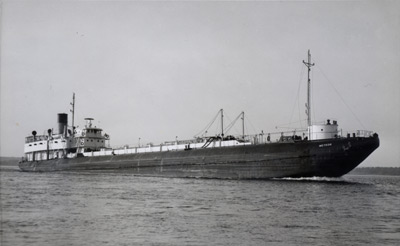Table of Contents
| Title Page | |
| Meetings | |
| Marine News | |
| Queen Of The River | |
| Ship of the Month No. 2 "Meteor" | |
| Vessel Passages | |
| Late News | |
| Members' Exchange | |
| Table of Illustrations |
West Superior, Wisconsin, was the scene as Hull 136 of the American Steel Barge Co. began her life in the year of 1896. She was built as a member of the fleet of whalebacks designed by Alexander McDougall on the theory that, if a ship wore shaped so as to let the seas wash over the deck with little or no resistance from the superstructure, then little damage would result from a struggle with heavy seas. The vessels had rounded decks, pointed bows and sterns, hatches that were flush with the decks and cabins that were raised off the decks by means of steel turrets.

Whaleback tanker METEOR downbound at Little Rapids, Sault Ste. Marie, Michigan, June 18, 1953. Photo by J. H. Bascom
The FRANK ROCKEFELLER, as our steamer was christened, differed from her many companions in three ways. She was the second largest lake-built pure whaleback freighter, she carried an unusual triple-deck bridge structure forward of the after cabin and she survived longer than any other vessel of her type.
ROCKEFELLER, given official number 121015, was 366.5 feet in length, 45 in width, and 26 in depth with a tonnage of 2759.86 gross, 2013.55 net. She was originally registered in Buffalo and was operated by Pickands, Mather & Co., Cleveland, who managed the American Steel Barge fleet until 1900. At this tine, the remaining units of the fleet were purchased by John D. Rockefeller, a noted American industrialist, who was at the time operating the Bessemer Steamship Co., to transport his ore cargoes. In February 1901, J. Pierpont Morgan and Elbert H. Gary were assembling their huge United States Steel Corp. and its Great Lakes fleet, the Pittsburgh Steamship Company, Having purchased the same month the steel and shipping interests of Andrew Carnegie, they naturally cast their eyes on Rockefeller's holdings and the purchase was completed the following month, the FRANK ROCKEFELLER becoming a unit of the largest American fleet ever to sail the lakes. Until 1905, she had a green hull, white cabins and an all-silver stack but thereafter she appeared with the familiar red hull while the stack gained a black smokeband.
She served the Pittsburgh fleet well until sold in 1927 to the Central Dredging Co., and renamed SOUTH PARK. In the 1930's she passed to the Nicholson Universal Steamship Co., Detroit, and was converted for use as an auto carrier by the construction of raised wooden sides and a flat deck. For a period she was operated by the Erie Steamship Co., Cleveland. The Overlakes Freight Corp., became the force behind Nicholson Universal when the New York Central Railway was forced to dispose of its interests in the business. SOUTH PARK was reconverted for use in the bulk trade at the onset of American involvement in World War II but the service lasted only until 1942.
Late in that year, she was caught in a gale on Lake Michigan and was driven hard aground near Manistique, Michigan. Salvaged some time later, she was rebuilt in 1943 as a tanker for Cleveland Tankers Inc., the work being done by the Manitowoc Shipbuilding Co. Her tonnage was then increased to 3383 gross, 2393 net, and she entered service as the METEOR. She emerged with a more conventional type of after cabin with a somewhat box-like upper deck.
The METEOR still serves in her latest role as the only whaleback tanker ever to operate on the Lakes, and her original triple expansion engine still gives her 2000 horsepower. She is known for her capabilities as an icebreaker, enabling her to maintain the difficult Lake Michigan winter service. She has not been seen in the Toronto area for some years.
And so METEOR sails on long after the disappearance of her many sisters whose wet decks and less than commodious accommodations were cursed by many a seaman. The whalebacks were relegated in their later days to the grain, stone and auto trades because of their small size. A number drifted off to salt water as did COLGATE HOYT; others, like JAMES B. NEILSON , were scrapped during the thirties, while a steamer and two barges finished their days in the Canadian grain trade. And some, like the JAMES B. COLGATE fell victim to the very seas they were designed to overcome. In not too many years, the venerable METEOR will join her departed sisters and the story of the "pig boats" will exist only on the written page and in the memories of those who knew them well.
Previous Next
Return to Home Port or Toronto Marine Historical Society's Scanner
Reproduced for the Web with the permission of the Toronto Marine Historical Society.